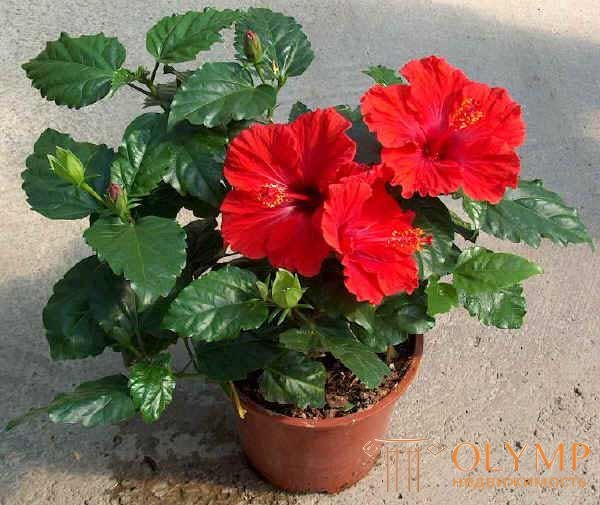
Latin name: Hibiscus rosa-sinensis Linn.
Family: Malvaceae - Malvaceae
Homeland: Southeast Asia, Polynesia
Growing up: For a beginner
Lighting: Bright light
Humidity: Moderate

Description:
Rod wears an ancient Greek. stock name Rose Alcea rosea L. About 300 species, common in tropical and subtropical areas.
Hibiscus is the flower of Hawaii and the national flower of Malaysia. It has many species and varieties. The color scheme includes all colors except blue and black. Flower size ranges from 5 to 30 cm. Interest in hibiscus arose at the beginning of the last century in Hawaii. In 1950, the American Hibiscus Lovers Society was founded. High plant, in favorable conditions, reaches 3 m in height. Evergreen shrub with spreading branches and shiny leaves. The flowers are large, simple and terry in structure. In some plants, they are purple-red, pink, orange. Nowadays, excellent rose hybrids are grown. It blooms from early spring to autumn, and sometimes in winter. The buds open alternately. After pollination, the flowers fall. Sometimes a fruit is tied - a box.
The hibiscus bush lives for 20 years or more, lends itself well to molding: at the end of winter pruned stems to increase branching.
Hibiscus species:
Syrian hibiscus (Hibiscus siriaca) - grows in the southeastern corner of Transcaucasia, tribed hibiscus (Hibiscus ternatus Cor.) (Northern), reaching to the south of Ukraine and extending further in Western Europe. Therefore, in the temperate zone in the open air, they succeed only in areas with the weakest winters, for example, on the southern coast of the Crimea. Even in southern Germany, they do not tolerate the local climate particularly well.
The most common species is marsh hibiscus (Hibiscus moscheutos L.), with large flowers, up to 12 cm wide, pink with purple or carmine spots at the base of the corolla.
In addition to these, there are several dozens of species and varieties that are used not only as ornamental plants. For example, hemp hibiscus, or kenaf (Hibiscus cannabinus L.), gives excellent spinning material, for which it is bred in all tropical countries.
Chinese hibiscus, Chinese rose - H. rosa-sinensis L.
Evergreen shrub or small tree up to 4.5 m tall with brownish, sometimes almost black bark on old shoots. Leaves up to 15 cm long, alternate, petiolate, ovate or oval, at least in the upper half serrate, glabrous, shiny. Flowers axillary, solitary, on long stalks, at the base of them several linear bracts. Calyx funnel-bell-shaped, green, up to 3 cm long. The rim is separate, up to 10-12 cm in diameter, five-membered, of various colors from white to yellow and dark purple. The filaments grow together into a tube that is far out from the flower and contains a pistil stalk, topped with a stigma sticking out above the tube.
It blooms almost all year round. Flowers bloom only a day or two, but with proper care, new flowers will appear from spring to autumn. The natural flowering time is winter.
The homeland is Southeast Asia (South China) and Polynesia, northern India. In a culture before 1831. Numerous garden forms are known, differing in the degree of terryiness, size and color of flowers.
Young plants should be replanted annually, and then - as needed. To give the plant a decorative shape, it should be pruned. Hibiscus reacts to a change in the angle of incidence of light by dropping flower buds. Excessive watering or drying earthen coma, a sharp fluctuation in temperature or lack of light also cause dropping of the kidneys. In case of insufficient air humidity, the leaves shrivel.
In order to delay flowering until autumn or winter, it is necessary to replant and cut the plants in May. Before that, they should be at rest with very moderate watering. In July, cut again. As a result, flower buds are formed only in early autumn.
The plant grows well in hydroponics.
Что бы оставить комментарий войдите
Комментарии (0)